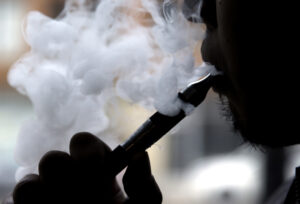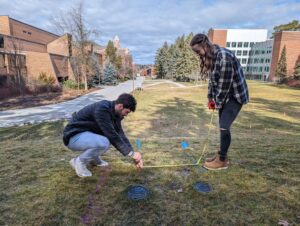Citizen scientists lead the way
Last month, when Washington state entomologists eradicated the first Asian giant hornet nest of the year, they were quick to give credit to the public for reporting suspected sightings that helped them locate the nest.
Now, the Washington State Department of Agriculture says help from the public in reporting sightings and backyard traps is key to tracking and containing the invasive pest.
“We wouldn’t have known anything about the nest if the public had not reported it to us,” Karla Salp, public engagement specialist for the WSDA, said. “Last year, half of our positive identifications came from reports from the public. This year, so far, all of them have been reported by the public.”
The hornet — the largest in the world — first appeared in Washington in 2019, but WSDA entomologists have partnered with the public to track and destroy nests in the northwestern corner of the state. The so-called “murder hornets” pose risks to honeybee populations if left unchecked.
Officials located the first nest of the year near Blaine, Washington, after a Whatcom County resident reported the first live hornet sighting of the year in August. WSDA entomologists confirmed the suspected sighting the next day, and two weeks later officials eradicated the nest about a quarter mile from the initial sighting. The WSDA has since eradicated a second nest and located a third in the same general area.
The WSDA’s citizen-scientist trapping program was largely driven by the public, Salp said.
“People were wanting to know how to build traps and where to put traps,” Salp said. “We thought, well if they’re willing to take the effort of researching and trying to find something they can do to help, maybe they’d participate in a coordinated effort. They definitely have.”
The WSDA provides instructions for citizen scientists to make their own traps at home if they choose to participate in the trapping program. The trap is a two-liter bottle with a star-shaped opening about a third of the way down. The bait is a mixture of orange juice and rice vinegar. A string is then attached around the neck of the bottle so it can hang from a tree.
The WSDA instructs citizen scientists to log the location of the trap on the WSDA’s Hornet Watch Trap Submission Map. Only catches of suspected Asian giant hornets need to be reported to the WSDA.
Steven Gilmore started making traps for Asian giant hornets because he was concerned about his honeybees. Gilmore, a retired senior manufacturing manager from Boeing, is a beekeeper in the Kayak Point area, about 50 miles south of Bellingham. This is his third season setting traps for the hornets.
“The key is adequate coverage,” Gilmore said. “We need as many people out there as possible to cover as much ground as possible. The WSDA has their hands full so it’s important to have people out there helping them out.”
Gilmore has never caught an Asian giant hornet but remains persistent. He thinks it’s possible to catch one if the species moves far enough south. He typically finds yellow jackets and bald-faced hornets in his traps, which are also a threat to honeybees. He calls this a “beneficial side effect” of setting traps.
Trapping Challenges
One of the challenges the WSDA faces in attempting to eradicate the species is the lack of an effective trap. Asian giant hornets will go into traps, but the traps do not seem to be very attractive, Salp said.
There were traps all over the area of the first eradication, but none of them caught an Asian giant hornet, Salp said. Without an attractive trap, it is even more critical for citizen scientists to keep their eyes open and report sightings.
While the likelihood of citizens successfully trapping Asian giant hornets remains low until a better trap is developed, the WSDA still invites everyone in Washington to participate in trapping. State entomologists are particularly interested in trapping information from Whatcom, Skagit, Island, San Juan, Snohomish, King, Jefferson and Clallam counties. The population seems to be contained in the northwest corner of Whatcom County. Trapping season runs from July to November, when worker hornets are active.
“Whether they are trapping for the Asian giant hornet as part of the trapping program, or just keeping their eyes open and reporting suspected sightings, both of these have been proven effective ways to positively identify Asian giant hornets that we otherwise would not have known about,” Salp said.
Most reports from the public tend to be false sightings; however the WSDA would rather sift through false sightings to get to the very few that are Asian giant hornets than receive no reports at all, Salp said.
Fear Likely Overblown
The arrival of the Asian giant hornet sparked a lot of media coverage and attention from the public in 2019. Timothy Lawrence, director of Washington State University’s extension office in Island County, said people have called him from all over the country and sent photos of bumblebees, cicada killers, general wasps, and even a June beetle thinking they were Asian giant hornets.
Lawrence worries about people overreacting and killing bumble bee queens because they thought they were Asian giant hornets. He sees the value of citizen-science programs in the overall awareness and information they bring to the public.
There’s a lot of misinformation out there about the Asian giant hornet, Lawrence said. So far, the arrival of the Asian giant hornet has not had any significant impacts on the honeybee industry or the agriculture industry.
“It’s going to be an annoyance at best, but it is not going to be a huge problem, even in the worst scenario that the Asian giant hornet gets established. And we’re a long way away from being able to say that’s the scenario,” Lawrence said.
As for eastern Washington, Lawrence said it is likely too hot and dry for the Asian giant hornet to establish here.
“It’s certainly a pest that we don’t want,” Lawrence said. “Right now, the current body of knowledge is telling us that it’s a concern, but it’s not the end of the world. To define it as anything more than an annoyance right now, I think is overstated.”
Nevertheless, public engagement and awareness are still key to containing the Asian giant hornet infestation.
“The public is giving us a chance at eradicating this pest,” Salp said. “Without the public we would not be where we are today, and the Asian giant hornet would be well on their way to establishing in Washington state.”















